Have you ever asked yourself: Can Green Diwali be about planting more than bursting crackers?
What if our festival of lights could also be a festival of leaves?
Could “Green Diwali in India” become a new tradition in every home?
If you nod yes, you’re in the right place.
In this blog, we’ll explore Green Diwali in India in depth, why it matters, how to begin, and seven tree-loving traditions you can adopt this very Diwali.
We’ll keep it straightforward, crisp, and full of actionable ideas; with subtle support for Nelda Foundation’s mission as we go.
What is Green Diwali in India?
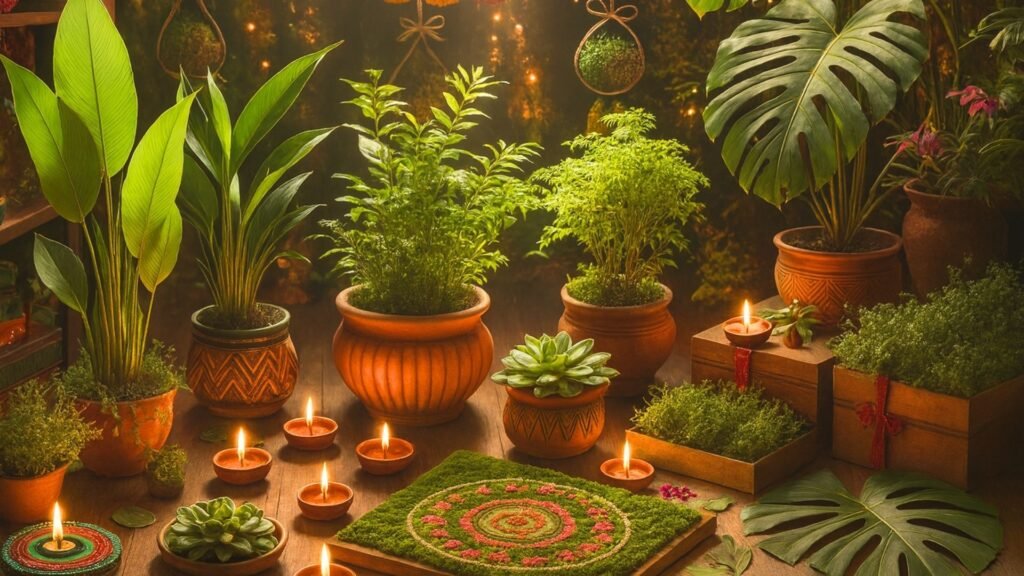
Green Diwali in India is a growing movement to celebrate the festival of lights in an environmentally responsible, sustainable, and eco-friendly way.
Traditionally, Diwali celebrations in India involve bursting firecrackers, using synthetic decorations, and heavy electricity consumption.
While these practices create a festive atmosphere, they also generate air pollution, noise pollution, and large amounts of non-biodegradable waste.
Green Diwali in India aims to reverse these effects by encouraging people to celebrate in harmony with nature.
It’s about replacing pollution-causing activities with eco-friendly rituals; planting trees, using clay diyas instead of electric lights, gifting plants instead of plastic hampers, and adopting biodegradable materials for rangoli and décor.
At its core, Green Diwali in India is not just a set of practices but a mindset shift.
It reflects a commitment to reducing environmental damage while preserving the joy and spirituality of Diwali.
This means lighting homes with earthen lamps and solar-powered LEDs, decorating with flowers and leaves, and organizing community tree planting instead of loud cracker displays.
Another key aspect of Green Diwali in India is education and awareness.
Families teach children about the benefits of conserving nature, local NGOs promote sapling distribution drives, and communities unite to create a low-impact festival.
For example, Nelda Foundation, which focuses on planting and nurturing trees across India, encourages households and communities to mark each Diwali by planting native saplings.
This not only supports biodiversity but also creates a living, long-term symbol of the festival.
The significance of Green Diwali in India goes beyond one night of celebration.
It fosters habits like composting, waste segregation, water conservation, and tree care, turning Diwali into a catalyst for year-round sustainability.
This approach keeps the cultural spirit of Diwali intact; celebrating light over darkness and good over evil; but adds a modern layer of environmental responsibility.
By embracing Green Diwali in India, families contribute to cleaner air, greener surroundings, and healthier communities.
It’s a powerful example of how cultural traditions can evolve to meet contemporary challenges without losing their essence.
As more people adopt Green Diwali in India, this eco-friendly festival could become the new norm, inspiring other countries and communities to rethink their celebrations too.
Why Green Diwali in India Matters?
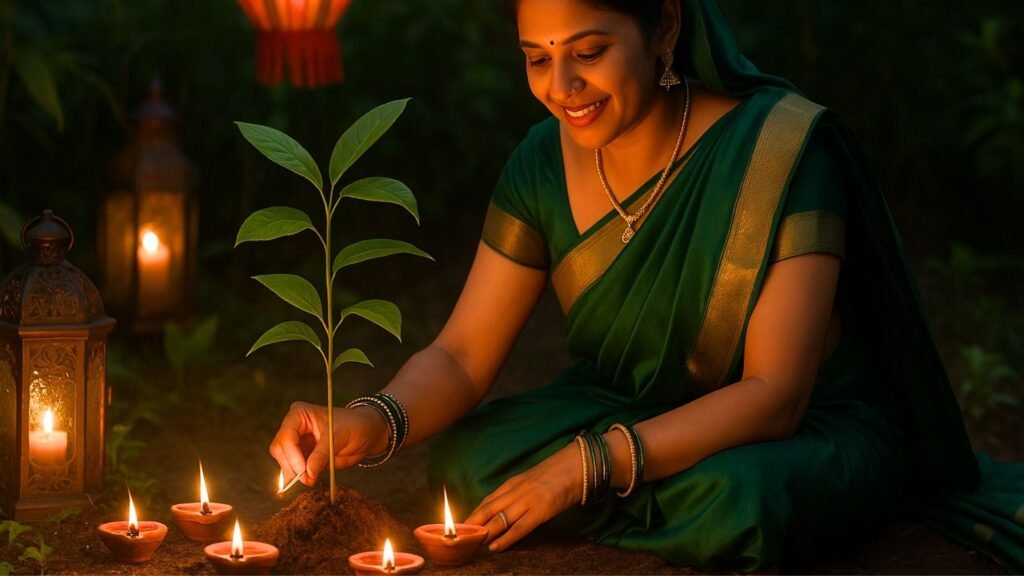
Diwali is a festival of light, joy, and togetherness. But the way it is often celebrated today creates serious environmental challenges.
Firecrackers increase air pollution, synthetic décor adds to plastic waste, and heavy electricity use strains natural resources.
This is why shifting toward a Green Diwali in India has become essential.
By celebrating responsibly, we can enjoy Diwali while also protecting our health and the planet.
A Green Diwali promotes eco-friendly traditions that reduce pollution, save energy, and bring communities closer to nature.
Planting saplings, using natural décor, and gifting greenery make the festival more meaningful and sustainable.
Key reasons why Green Diwali in India matters:
- Reduces air and noise pollution caused by crackers
- Encourages tree planting and biodiversity growth
- Preserves cultural traditions like lighting diyas while being eco-conscious
- Creates awareness among children about sustainability
- Leaves a positive legacy for future generations
Choosing Green Diwali in India ensures the festival remains a celebration of prosperity and happiness, without harming the environment.
7 Tree-Loving Traditions for a Green Diwali in India

Diwali is a festival of light, renewal, and prosperity, and what better way to honor its spirit than by nurturing the environment that sustains us?
Embracing Green Diwali in India is not just about avoiding crackers or saving electricity; it’s about adopting traditions that leave behind a greener legacy.
By bringing trees and plants into the heart of our celebrations, we can ensure that Diwali becomes a time of giving back to nature as much as it is about joy and togetherness.
Below are seven simple yet powerful tree-loving traditions you can start this year to make your Diwali truly eco-friendly and meaningful.
1. Plant a Sapling for Every Diwali With Your Family

The most powerful tradition is also the simplest: plant a tree.
- Choose native Indian species like neem, banyan, jamun, peepal, or amla.
- Plant in your yard, terrace pots, housing society gardens, or community open spaces.
- Involve children so they grow with the tree.
- Mark each Diwali with one new tree.
Over the years, your family can build a mini forest. Imagine your grandchildren celebrating Diwali in the shade of the saplings you planted.
That’s the legacy of a Green Diwali in India.
Nelda Foundation regularly organizes tree planting drives and supports citizens with saplings, training, and care programs.
Planting with Nelda means your efforts become part of a billion-tree vision.
2. Natural Rangoli & Green Decor
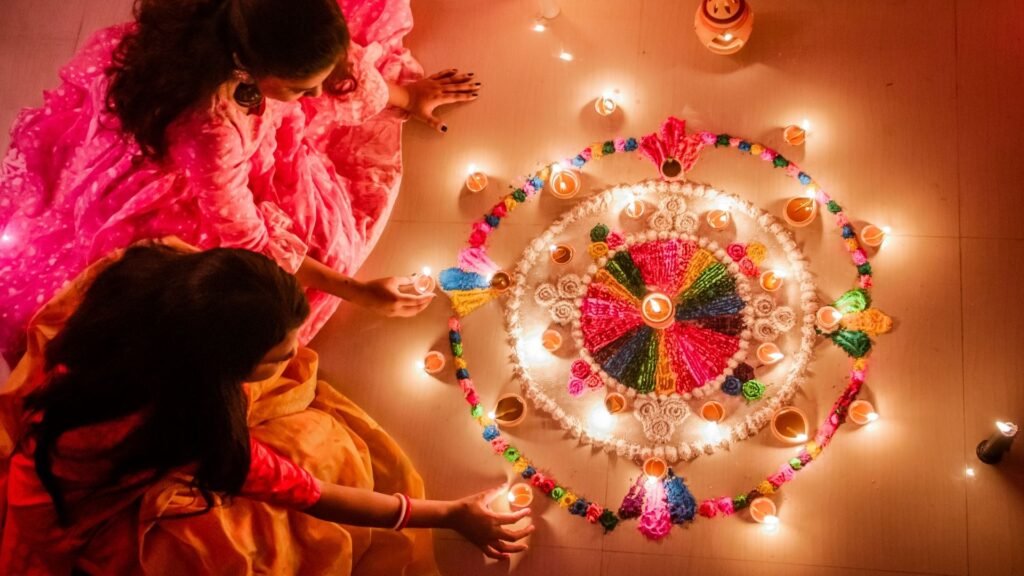
Replace synthetic colors and plastic decorations with natural, biodegradable materials.
- Use flower petals, turmeric, rice flour, beetroot juice for rangoli.
- Make torans with mango leaves, neem leaves, or marigold garlands.
- Decorate with small potted plants or herbal saplings.
- Reuse cloth, bamboo, or jute for festive décor instead of plastic.
These choices reduce waste while making homes look beautiful. Plus, they fill the air with fragrance and color, unlike chemical powders that harm soil and water.
By making your décor eco-friendly, you live the essence of Green Diwali in India every time you light your home.
3. Skip Firecrackers or Use Green Alternatives
One of the hardest traditions to change is also the most harmful.
Firecrackers have become synonymous with Diwali celebrations, but they are a major contributor to air and noise pollution.
Every year after Diwali night, the air quality index in Indian cities spikes to hazardous levels due to the release of particulate matter, toxic gases like sulfur dioxide, and heavy metals.
This impacts everyone’s health, especially children, the elderly, and people with respiratory conditions.
Animals too suffer from the loud noises, often becoming frightened or disoriented.
Options for a Green Diwali in India include:
- Green crackers with reduced smoke and chemicals.
- Seed crackers that scatter plantable seeds when they burst.
- Lanterns, diyas, solar lights as peaceful alternatives.
Every time you choose not to burn crackers, you gift your city a little cleaner air. And the joy of calm celebrations is equally powerful, especially when paired with tree planting.
4. Eco-Friendly Gifting

Gifting is integral to Diwali. But plastic hampers and synthetic wrapping add to waste.
Instead, opt for:
- Potted plants, bonsai, succulents as gifts.
- Seed kits or seed bombs.
- Organic food hampers, handmade soaps, cloth items.
- Recycled or cloth wrapping, no shiny plastic sheets.
By gifting greenery, you encourage others to join the Green Diwali in India movement.
Nelda has pioneered sapling distribution drives, imagine giving your loved ones not just a gift, but a living tree.
5. Sustainable Lighting
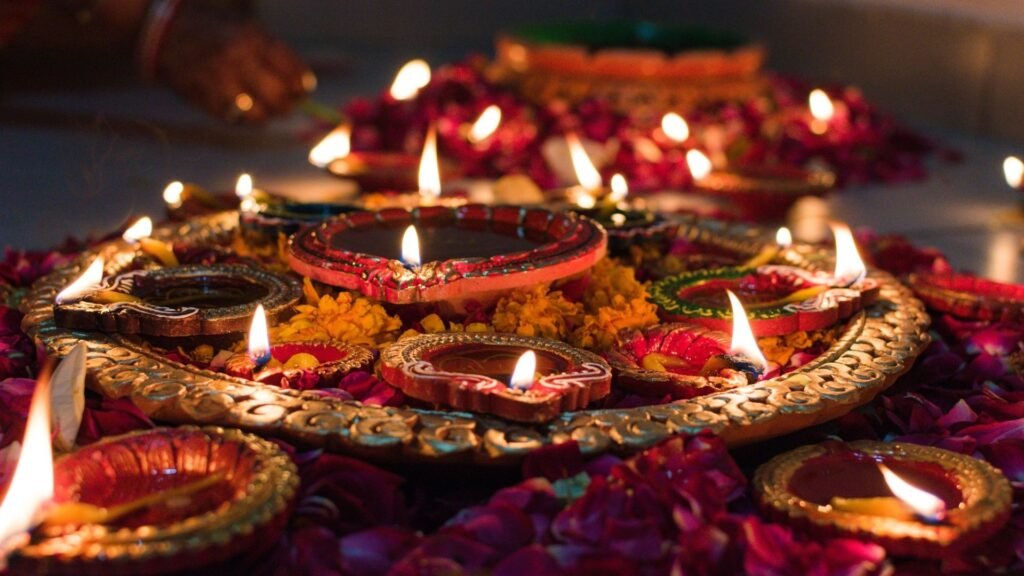
Diwali has always been known as the “festival of lights,” and illumination is central to its charm.
But celebrating with light doesn’t have to mean wasting electricity or relying on non-eco-friendly options.
Adopting sustainable lighting practices is one of the easiest yet most meaningful steps toward a Green Diwali in India.
Instead of using heavy electric string lights for long hours, start by embracing traditional clay diyas filled with ghee or oil.
- Light clay diyas with ghee or oil.
- Use solar-powered LED lights for decorations.
- Minimize usage hours – switch off when not needed.
- Cluster diyas for stronger light and reduced oil use.
This way, you balance tradition with modern sustainability. Lighting that nurtures, not drains, is at the heart of a Green Diwali in India.
6. Community Tree Ceremonies

Celebrating a Green Diwali in India doesn’t need to stop at your doorstep.
The real transformation happens when communities come together, making eco-friendly practices part of collective traditions.
A wonderful way to do this is by hosting community tree planting ceremonies during Diwali.
Gather your neighbors, society members, or local groups and organize a planting drive in a common space, it could be a park, a housing society courtyard, or even a nearby barren plot that can be revived.
Planting together not only multiplies the number of trees but also strengthens bonds within the community.
- Host a tree planting ceremony in your colony or society.
- Light diyas near the saplings after planting.
- Assign families to care for individual trees.
- Partner with Nelda for sapling supply and training.
When entire neighborhoods embrace this, Green Diwali in India turns into a collective celebration. Children learn, families bond, and the community thrives.
7. Storytelling & Green Pledges

One of the most powerful ways to preserve and evolve tradition is through stories.
Culture lives in the conversations we share, the values we pass on, and the habits we nurture within our families.
During Diwali, when families gather for poojas, sweets, and celebrations, it’s the perfect moment to introduce eco-conscious storytelling and green pledges, turning the festival into a catalyst for lasting change.
- Tell children about forests, rivers, and the value of trees.
- Create a family pledge: plant 10 trees, compost waste, or reduce plastics.
- Share experiences on social media with #GreenDiwaliInIndia.
When families pledge, Diwali transforms from a one-day festival into a year-long lifestyle of eco-care. That’s the future Green Diwali in India envisions.
Practical Tips for Success
While the idea of celebrating a Green Diwali in India sounds inspiring, it becomes truly impactful when combined with practical steps that ensure long-term results.
Small actions, done consistently, make your eco-friendly traditions stronger and more effective. Here are some simple yet powerful ways to make your efforts last beyond the festival:
- Pick native species for better survival rates: Always choose trees and plants that naturally thrive in your region, such as neem, peepal, banyan, jamun, or gulmohar. Native species adapt quickly to local soil and weather, require less maintenance, and support biodiversity by attracting local birds and insects.
- Compost kitchen waste for soil enrichment: Instead of discarding fruit peels, vegetable scraps, and garden waste, turn them into nutrient-rich compost. This reduces landfill waste and provides organic fertilizer for your saplings, giving them a healthy start.
- Protect saplings with guards or fences: Newly planted saplings are vulnerable to animals, trampling, and harsh weather. Use bamboo guards, wire mesh, or simple fencing to keep them safe until they grow stronger. Regular watering and seasonal mulching will further increase their survival rate.
- Involve schools and young learners: Children are the most enthusiastic ambassadors of change. Encourage schools to adopt saplings, organize eco-clubs, or hold storytelling sessions around tree planting. When children connect with nature early, they carry those values for life.
- Document and share growth: Take photographs of the saplings you plant during Diwali and track their growth year by year. Sharing these updates on social media or within your community not only inspires others to act but also creates a living record of your family’s eco-legacy.
Partnering with organizations like Nelda Foundation adds an extra layer of assurance.
Nelda provides saplings, training, and long-term care support, ensuring that the trees you plant don’t just survive but flourish into mature green guardians.
By volunteering with Nelda, you can also become part of larger community initiatives, multiplying the impact of your individual actions.
When combined, these small but consistent steps ensure that your Green Diwali in India isn’t just symbolic but becomes a real force of change for the planet.
Broader Impact of Green Diwali in India
The idea of celebrating a Green Diwali in India goes far beyond just one evening of eco-friendly festivities.
When more families and communities embrace this approach, the collective impact creates long-lasting benefits for both the environment and society.
- Cleaner Air: Skipping firecrackers directly reduces harmful particulate matter, sulfur dioxide, and carbon monoxide in the air. This means clearer skies, improved air quality, and less smog in cities. Families can breathe easier, and urban areas avoid the post-Diwali pollution spike that often reaches hazardous levels.
- Tree Cover Growth: Planting trees during Diwali contributes to biodiversity and improves green cover in cities and towns. Each sapling grows into a provider of shade, oxygen, and shelter for birds and insects, helping balance ecosystems. Over time, collective efforts can transform barren spaces into thriving green zones.
- Cultural Shift: When people start associating Diwali with planting saplings, using eco-friendly décor, and lighting diyas instead of crackers, it redefines tradition for the better. A Green Diwali in India gradually becomes the new normal, inspiring future generations to celebrate responsibly without feeling like they’re missing out.
- Health Benefits: Reducing pollution leads to fewer cases of asthma, allergies, and respiratory illnesses that typically spike after Diwali. Noise-free celebrations also reduce stress for humans and animals alike, making the festival truly joyful and inclusive.
- Community Bonding: Eco-friendly initiatives such as tree planting drives, composting workshops, or green gifting create opportunities for neighbors, schools, and NGOs to come together. Planting saplings as a group fosters pride, unity, and a shared sense of responsibility toward nature.
Ultimately, Green Diwali in India is not about limiting celebration; it’s about reshaping how we celebrate.
The broader impact lies in transforming urban India into healthier, greener, and more sustainable spaces.
When combined with long-term care and awareness, these efforts ensure that Diwali remains a festival of prosperity not just for people, but also for the planet.
How Nelda Foundation Helps You Celebrate Green Diwali in India?
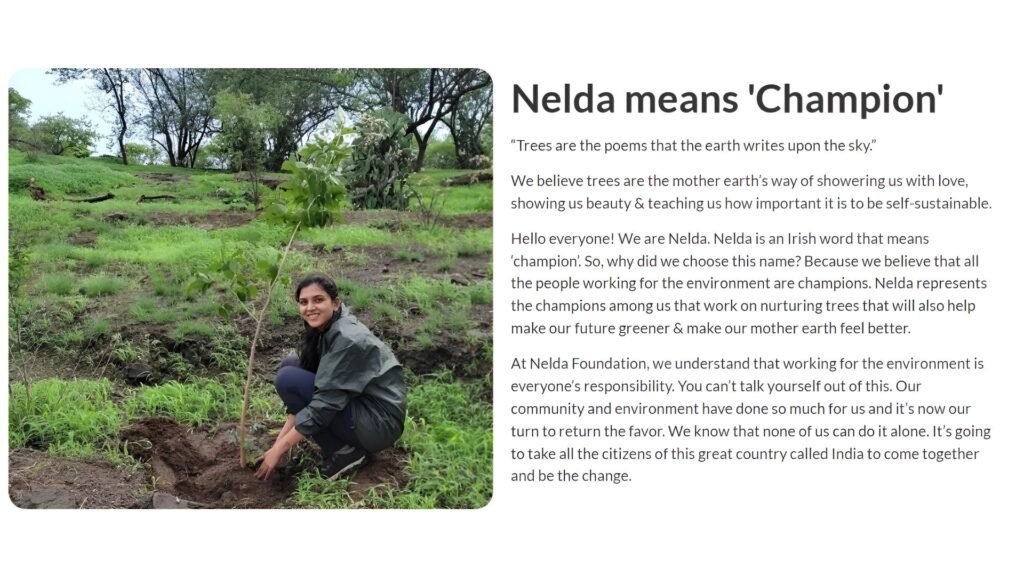
Celebrating a Green Diwali in India becomes more impactful when you join hands with organizations that are already working for the environment.
Nelda Foundation, based in Pune, is one such nonprofit dedicated to planting and nurturing trees.
Our mission is clear and ambitious: to help India grow a billion trees by 2041.
By aligning your Diwali celebrations with Nelda’s work, you can multiply the positive impact of your eco-friendly choices.
- Tree Plantation Drives: Nelda regularly organizes plantation activities in every where individuals and families can plant native saplings during Diwali. This turns the festival into a long-lasting gift for the planet.
- Sapling Distribution: You can support or sponsor saplings with Nelda and use them as green gifts for friends, family, or community members, replacing conventional plastic-heavy hampers.
- Tree Care and Maintenance: Planting is only the first step. Nelda ensures the saplings are watered, guarded, and nurtured so they grow into healthy, mature trees.
- Volunteer Opportunities: Families, students, and corporate groups can join Nelda as volunteers during Diwali to participate in planting events and awareness programs.
- Awareness and Education: Through workshops, blogs, and campaigns, Nelda spreads the message of sustainability and shows how small acts like using eco décor, clay diyas, and green gifts align with the bigger vision of a Green Diwali in India.
By working with Nelda Foundation, your Diwali celebration is no longer limited to your home. It extends into communities, public spaces, and the environment at large.
Together, your efforts become part of a larger movement, one that transforms Diwali from a single night of lights into a legacy of greenery and sustainability.
Conclusion
Diwali is a festival that celebrates light, prosperity, and new beginnings.
But as we face growing environmental challenges, it is important to ask ourselves: can our celebrations also protect the very world we live in?
The answer lies in adopting the spirit of a Green Diwali in India.
By planting trees, choosing sustainable lighting, avoiding harmful crackers, and practicing eco-friendly gifting, we can redefine Diwali as a festival that honors both tradition and the environment.
Small actions like using clay diyas, composting kitchen waste, or gifting a potted plant may seem simple, but when multiplied by millions of families across the country, the collective impact is extraordinary.
Cleaner air, healthier communities, greener cities, and a cultural shift toward sustainability all begin with these choices.
A Green Diwali in India is not about giving up joy; it is about celebrating with deeper purpose.
It preserves the essence of Diwali, celebrating light over darkness and good over evil, while ensuring that our celebrations do not harm future generations.
In fact, choosing eco-friendly traditions makes the festival even more meaningful, as it leaves behind a living legacy of trees, healthier air, and a stronger connection with nature.
Organizations like Nelda Foundation are already leading this movement with large-scale tree plantation drives, community awareness initiatives, and volunteer programs.
By supporting such efforts or simply starting with a sapling at home, every individual can contribute to a billion-tree vision and a greener tomorrow.
This Diwali, let us choose to celebrate responsibly. Let us light diyas, plant trees, share eco-friendly stories, and pledge to protect the planet.
Together, we can make Green Diwali in India not just a concept, but a tradition that grows stronger every year.
So, will your Diwali only light up the night sky, or will it also light up the future?
Make the choice today: celebrate a Green Diwali in India and leave behind a legacy of hope, health, and harmony.
FAQs
Q: How can I celebrate Green Diwali in an apartment?
A: Use potted plants, balcony gardens, solar lights, and eco gifts. Even small acts count.
Q: Which trees are best to plant during Diwali?
A: Native species such as neem, jamun, banyan, peepal, and amla. Nelda can guide you on the right saplings for your region.
Q: How can Nelda Foundation help me celebrate Green Diwali in India?
A: Nelda provides saplings, organizes planting drives, trains volunteers, and helps communities maintain trees long-term.

